10 Small Changes That Can Make You Faster
Big wins don’t just happen. They’re the culmination of tens, often hundreds of smaller everyday wins that mold you into a stronger, faster cyclist. These small wins, better known as marginal gains, can help you overcome that all-too-often frustratingly small gap between winning and losing on race day.
To help you bridge that gap, I’ve put together a list of ten ways athletes training indoors can get the absolute most out of their efforts on the bike. If you focus on implementing each of these recommendations into your training, your results — albeit minor — will be significant. Let’s get to it.
1. Pay Attention to Workout Text
Most TrainerRoad workouts come with in-workout instructional guidance that we refer to as Workout Text. Workout Text provides you with on-screen instructions during your workout to help you nail your intervals, remind you to adjust your posture and provide you with other riding tips during specific portions of your workout.
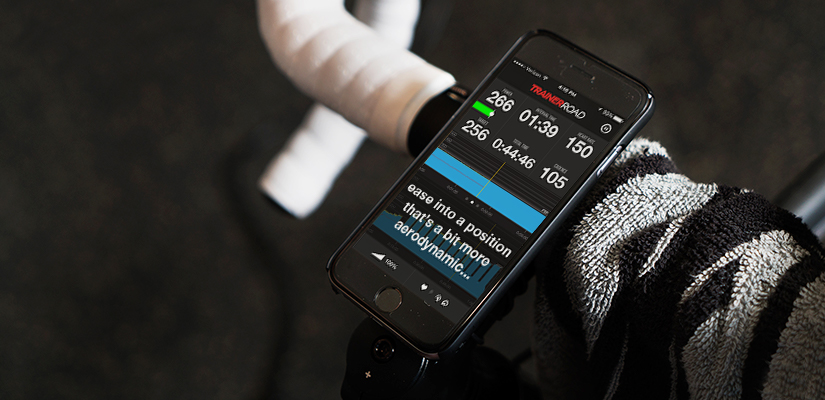
The greatest benefit of Workout Text is that it keeps you focused throughout your time on the trainer. It lists and prioritizes the goals of each workout by telling you what to expect before you begin. It also explains how to address each goal over the course of your workout so you get the most of your training from your warm-up to work intervals and even you cool-down.
Complex drills generally contain more Workout Text — both in terms of their intended benefit and instructions for proper techniques to cultivate optimal cycling habits. Together, Workout Text effectively covers how to conduct your workout and why you’re doing it. Plus, the occasional dash of dry humor keeps your spirits high so you can focus on your goal.
2. Know the Outcome of Your Workout Before You Begin
For cyclists who want to win, there’s more to a workout than simply getting it done — that kind of mentality only gets you so far. To get the most out of your time on the trainer, you should know exactly what the goal of your workout is and how to achieve it before you begin.
The easiest way to do this is to read my workout description. When you’re a TrainerRoad athlete, you have access to 1,000+ cycling workouts, each equipped with a workout description that outlines what you can expect and which areas to focus on while you train. Every time you get on the trainer to workout, you’ll know exactly what you’re getting yourself into before you begin.a
Setting a goal for your workout before you jump in the saddle gives yourself additional room to focus on one specific training aspect at a time. For example: If you know your cadence needs some work, focus on improving cadence alongside completing your workout. Focusing on one goal at a time and what you’d like to accomplish before you begin will help you get more of your time on the trainer than going in blind.
3. Find the Best Time of Day to Train
Our body’s internal clock is based off what’s known as a circadian rhythm. It’s what differentiates early birds from night owls and it’s what makes you more or less productive during certain times of the day. You can get more out of your training by working when your body is the most ready. Keep in mind, this changes for everyone.
Training in accordance to your circadian rhythm is all about taking advantage of when your body is at 100%. Rest and recovery affect nearly every aspect of your health: hormonal balances, blood pressure, mental clarity, etc. Aligning when you train with your body’s optimal time for high performance places you in a better condition to succeed.
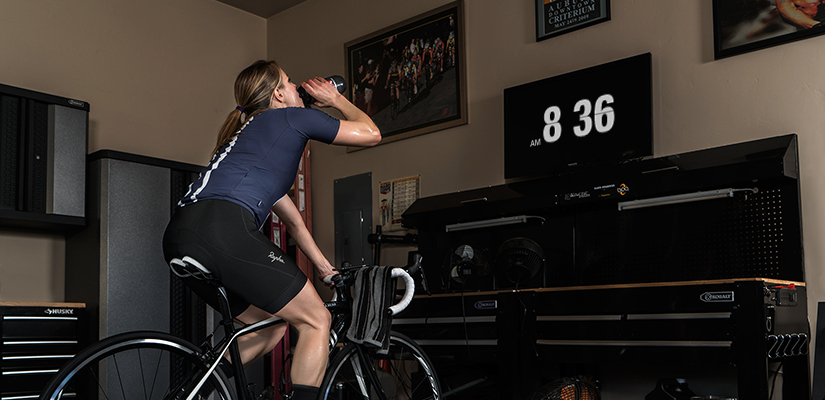
On the contrary, training against your body’s internal clock can leave you feeling fatigued and overworked. Putting this concept into perspective is pretty simple: just imagine trying to climb 50 feet on a 45-foot rope. No matter how hard you work, you’ll only get so far. When you’re training in an optimal state with your body’s internal clock, you’ve got all the rope you need to get where you want to go.
As you approach your goal event, a tip some cyclists like to implement is to adjust their training time to reflect their expected race time. This can be especially helpful if you’re training in a new time zone or during a time you wouldn’t usually be on the bike. Once you know when you’re set to race, train closer and closer to that time — a concept known as temporal specificity. Your body will benefit from the adapted training time to help you compete.
4. Adjust Your Nutrition According to Your Upcoming Event
Similar to adjusting the time you work out, adjusting what and how much nutrition you take in while you train can affect your performance for the better. Again, it’s all about familiarizing your body with a routine similar to what you can expect during your event.
For example: If you know aid stations provide small cups of Gatorade during your race, drink similar amounts of Gatorade while you train. It’s even better if you can time when you drink it according to your race as well.
Here’s another tip: Prepare your post-workout drink before you train if you plan to use recovery nutrition after especially depleting workouts. Mix it up and throw it in the fridge before hopping on the bike. You’ll save time after your workout which allows you to take advantage of your body’s carbohydrate-sensitive state to get the most rapid form of replenishment possible.
5. Choose the Right Attire for the Trainer
It’s become common practice for cyclists to use old worn-out kits and jerseys on the bike. Ultimately, there’s nothing wrong with it. However, wearing old kits can affect how your body manages heat, overall comfort and even how you view your time on the trainer psychologically.
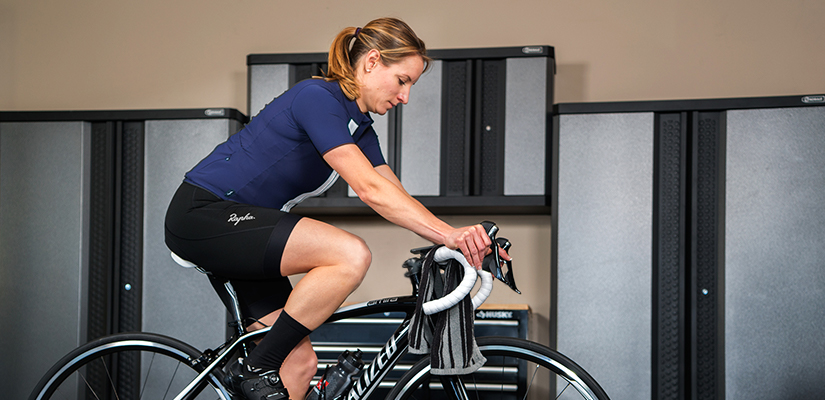
We cover heat management a little more in-depth in our Winter Training Guide, but here’s the lowdown: Heat management is a lot more than just feeling hot or cold — it’s about actually removing heat from your body to prevent overheating. In fact, roughly 75% of your energy consumption on the bike goes toward thermoregulation. That leaves 25% of your energy left to turn the pedals on your bike.
While old kits and chamois pads may be worn-in, they’re usually made from older material that doesn’t facilitate evaporative cooling. Plus, they might not provide the right comfort that’s so crucial to sitting in a fixed position for extended periods of time. If this is the case, older attire on the trainer may hurt you more than it helps you.
If you insist on wearing an older kit on the trainer, try wearing a mesh base layer underneath. This helps for two reasons: it’s more comfortable, and the extra layer will create space between your kit and the surface of your skin, aiding in your fight against overheating.
What you wear on the trainer can also affect your mental outlook on the trainer. The saying “feel fast, go fast” applies here. Wearing what your race-day kit can get your head in a more competitive and confident mindset, helping you put your best effort forward.
6. Adjust Your Fan Position
As I mentioned above, heat management is more than just feeling hot or cold. It’s about actually removing heat from your body. Using a fan is one of the best ways to manage your heat through evaporative cooling, and subsequently has become one of the most popular pieces of an indoor-training setup.
You’re doing yourself a disservice if your fan is pointed directly at your face. It may seem counterintuitive, but this isn’t the optimal position for your fan in respect to your trainer. Instead, try placing your fan 15-30 degrees to the left or the right of your bike (if the front of your bike is 12 o’clock, you should place your fan around 10 o’clock or 2 o’clock) with its airflow on your body’s central mass or torso.
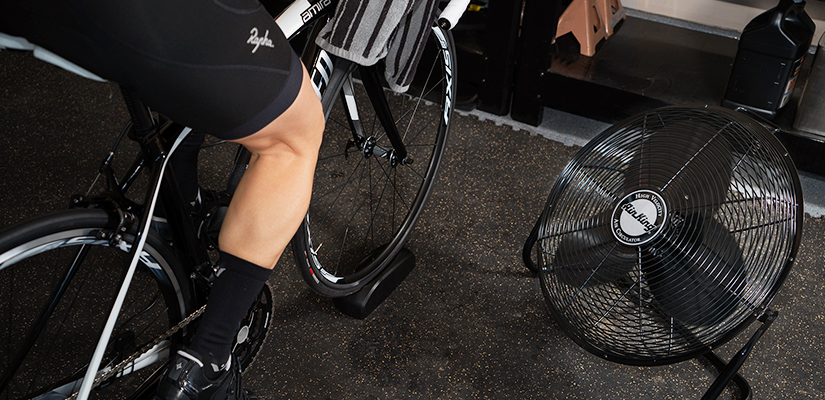
Placing your fan at this angle cools more of your body compared to placing it directly in front of your face. Cool air from the fan covers a wider surface area of your body and increases the effects of evaporative cooling more effectively.
In my personal setup I use two 18-inch fans — each are placed on the ground on both sides of my bike in this position. I aim them downward during my warmup then onto my legs and my torso. Doing so keeps me from getting too cold before my muscles have warmed up. It also makes it easier to finish my workout because I don’t have to get off the bike once I’m on to adjust them.
7. Refine Your Pedal Stroke
There’s a common misconception that there’s a singular best way to pedal your bike — this isn’t true. Each person’s physiology will have them pedaling a different circle than the rest, but that doesn’t mean you can’t make your specific pedaling style more efficient. Rather than focusing on how badly it hurts to pedal through difficult intervals, it’s far more productive to focus on improving your form. It’s tough, but worth it if you can nail this movement down!
A great time to establish proper pedaling habits is during lower-intensity workouts because you can focus on the nuances of your pedal stroke rather than just power output. Once you learn them, these habits will carry over to higher-intensity efforts where poor pedaling mechanics can actually contribute to power loss and joint or muscle injury. Pay attention to the position of your feet, how far your heels drop or toes point, their angle (inward or outward) and even the flare of your knees — all which you can find in great detail in the Workout Text and description.
The goal is to create even, strong pedalstrokes that cause no joint pain regardless of the intensity. For many riders, this means knees that are directly in line with the middle of each un-canted, un-angled foot, but many riders have bio-mechanical issues that are buried a bit more deeply that restrict a rider from following the pedaling recommendations exactly as their listed. Simply try to notice where they are naturally compared to where you’d like them to be, and gradually start working on them one by one over time. Making sudden or extreme changes can result in an injury, so don’t aim for overnight results. In some cases, you may want to reach out to your sports therapist or sports physician to ensure you avoid an injury.
8. Breathe With Your Belly
Many athletes have the tendency to breathe from the top of their chests. It might feel natural, but this isn’t how you should breathe when you’re on the bike and it can be a limiting habit when training.
Breathing from the belly — or low, from the diaphragm — allows you to take deeper breaths. This gets more oxygen-rich blood to your muscles and the rest of your body. The more oxygen in your blood and the more quickly you can deliver it to your muscles, the more efficient they become. As a result your muscles can work harder to help you reach the marginal gains you need in preparation of race day.
9. Train in Your Race Gear
Sometimes small wins come down to technicalities on your bike. Training in your race gear — the gear you’ll be in most when racing — is one of them. If you spend all your time training in the biggest ring and smallest cog, you’ll be used to high-inertia power output.
Showing up on race day facing a big, steep climb with this approach is going to present a challenge you might not be prepared for. Conversely, the same applies to a rider who trains in a low gear that shows up to a flat and fast TT.
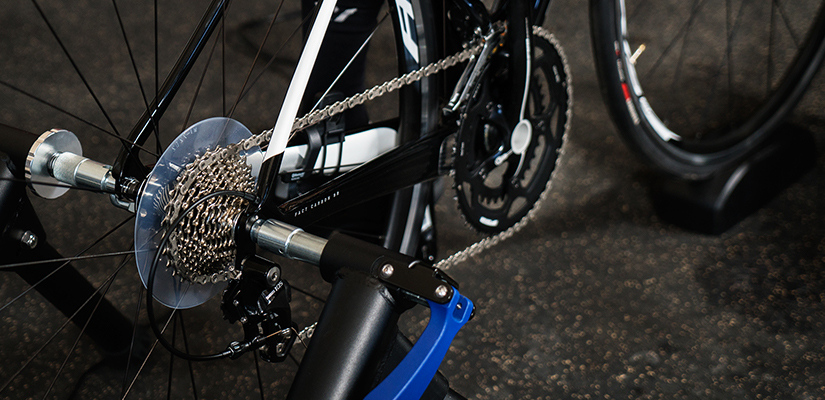
The point is this: Train in the gear that emulates the inertial demands of your goal race. This will give you the largest advantage over your competition, as your body will be ready to put out some serious power during your event.
10. Focus on Body Posture and Positioning
Your posture can have a significant effect on the productivity of your training. As you train, your body often slumps and your back tends to bunch up — especially near the end of your workout when you begin to fatigue. Your weight also tends to get poorly distributed and your body begins to contract in ways that can weaken your training.
When you’re on the bike, your goal should be to focus on positioning your body in a way that allows you to be as efficient as possible. This means a comfortably rounded back, a strong and stable core and relaxed arms for more power and control over your legs. You also want to pay attention to unnecessary muscle contractions throughout the rest of your body. Overly tense arm and back muscles can rob your legs of energy over time, so staying relaxed can make a significant difference to your overall performance.
Training in your race position can also help you prepare for success as you get closer to race day. This changes from person to person based on the type of event you’re preparing for, but you should start training in your race position during the Build Phase and increase your time in that position into your Speciality Phase of your structured training plan. 40k TT riders often race in more extreme aero positions, and Full-Distance triathletes require more time to fully adapt to their race position. If that’s the case, consider training in your race position as early as your Base Phase. Not only will you feel more prepared going into your race mentally, your body will be accustomed to performing in your race position.
Marginal Gains Help You Win
Whether it’s choosing the right attire when you get on the trainer or being diligent about following your workouts’ Workout Text, winning is the result of everyday practices that make you a better cyclist. Putting in the extra effort and focus can have a major payoff come race day, especially when the difference between winning and losing is so often just a few seconds.
I hope these tips were helpful! Let me know — along with any personal indoor-training tips of your own — in the comments below.
Are you dedicated to getting faster and becoming the best cyclist you can be? With our monthly or discounted annual memberships, you can use TrainerRoad and any of our 100+ properly structured training plans to get ready for your next big event.
